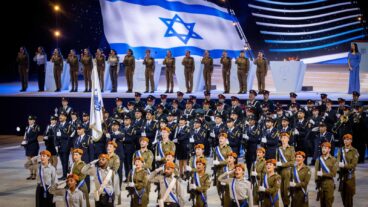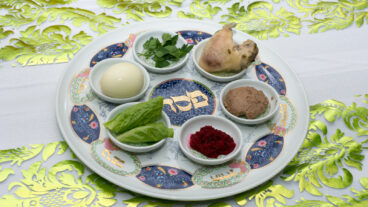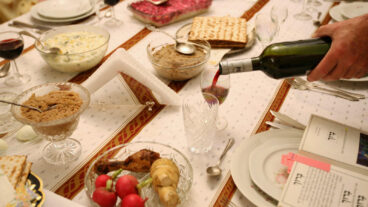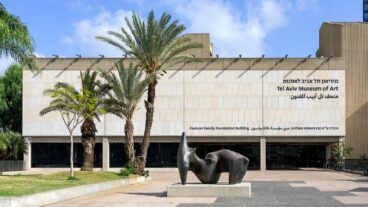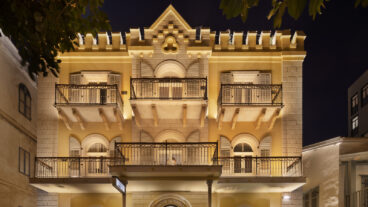From left – Noah, Tzachi, Brosh, and Ibtisam star in the Israeli version of Sesame Stories.It starts out like a scene that could be broadcast on Sesame Street in the U.S. Tzachi, a mild-mannered Jewish handyman wearing a turned-around baseball cap, is busy in his workshop accompanied by his Muppet assistants Noah and Brosh.
Then suddenly, Tzachi’s neighbor Ibtisam, an art student, walks into the room. She greets him in Arabic, they exchange friendly pleasantries, then asks if she can have the paint for a project she is working on. Tzachi agrees.
The young, naïve Noah looks at the two humans in wonderment, “Are you two friends? How is that possible? You are so different!”
This sparks a conversation about the different things that Ibtisam and Tzachi have in common and what is different about them. Between comparing their hair color, eye color and favorite hobbies, the two neighbors note the fact that Tzachi is Jewish and Ibtisam is Arab.
What sounds like casual conversation is carefully scripted by the team that has created Sesame Stories, the third incarnation of Sesame Street to air in Israel, whose creators hope to reinforce education for tolerance and prevention of violence.
This time around, Sesame Street has a unique twist: it’s part of a triad production – filming has taken place in Israel, Ramallah, and Jordan. Each of the entities is creating its own version of the show, using common materials, are simultaneously airing the show on the HOP! TV channel in Israel, Jordanian JRTV, and the Palestinian Ma’an Network.
The Israeli Sesame Stories production carries a message of hope, respect and understanding, and non-violent conflict resolution to children aged four to seven – but with messages hoping to influence their families as well. The series enables Israeli Jewish children to get to know their Israeli Arab neighbors and provides Israeli Arab children with the opportunity to see themselves as an expression of their culture on-screen. Through the segments filmed in the Palestinian Authority and Jordan, they also get to know their more distant neighbors better.
Content consultant Alia Abou Shmeiss, an Israeli Arab who lives in Jaffa, said that she said yes immediately when asked to participate in the project. “We wanted to give the Arab child a chance to define himself.”
In Israel, the four main characters, Noah, Brosh, Tzachi and Ibtisam deal with subjects like: pride and self-esteem, helping others, majority/minority issues and others. Woven throughout the show are Sesame Street classic library segments, starring the beloved and well-known characters like Ernie and Bert, Big Bird, and Elmo. Like other Sesame Workshop production, Sesame Stories addresses literacy skills, while also giving Israeli culture and tradition wide expression.
Writers from the Sesame Workshop have collaborated closely with child psychologists and educational advisors in making the three programs, with the participation and contributions of professional advisors from various fields, including education, psychology, sociology, and many more. The format of the program was developed on the basis of the educational goals of the program, as well as the research conducted before the production began.
Shmeiss said that since Israeli Arab society was heterogeneous, she consulted members of the community around the country when creating the Arab content on the program. “Unfortunately, in Israel today, culture is a one-way street – the Arab community is exposed to Israeli culture. We wanted to give expression to Arab culture on screen: to show the holidays, the deep multi-generation family connection and cultures, the holidays, and to give exposure to the Arab language.”
She worked carefully on creating the character of Ibtisam. “We wanted a young woman that that they could identify with and feel affection for: like a sister or an aunt.”
The producers of the show are trying to extend the reach of their messages beyond the television.
“We want to use this material on the ground, and move beyond simply showing it on the screen,” said Yael Bar Lev, the head content advisor for Sesame Stories.
To this end,Sesame Stories was planned from its inception as a multi-media project that dealt with values and subjects. By simultaneously using television and other supporting media, they would be able to give the viewer additional meeting points with the project’s characters and messages off-screen. This way, the child can repeat and process the viewing experience in other venues, such as via the internet, books, activities, preschool learning kits, and other enrichment materials developed by educational professionals and other specialists.
All these educational outreach materials will be designed for the Arab sector as well as the Jewish sector and will be produced in both languages in order to promote the social and educational goals upon which the series was built.
A centerpiece of the off-screen outreach initiative is the Sesame Stories Website, that is housed within the
HOP! Website. Children who would like to continue the experience of Sesame Stories and play with Brosh and Noah are welcome to visit the characters’ new home on the website.
The games in Noah and Brosh’s home allow children to experience and engage with subjects raised in the series such as: self esteem, understanding different points of view and others. This is one of the first web sites for young children in Israel that is also available in Arabic and that offers games and enrichment activities in both languages. Furthermore, the preschool area of the website, designed for educators in preschools and elementary schools, offers activities and material based on the series’ subjects. Other activities will comprise a separate parents’ area of the site.
This third Israeli version of Sesame Street reflects the sober times in which it was created. In the 90s at the height of Oslo and peace, there was a version where the Israeli puppets visited back and forth with their neighbors on a Palestinian Sesame Street. It was shot with a joint Israeli-Palestinian production team. Sesame Stories reflects the current reality – the action takes place in a private space. The idea of Israelis and Arabs mixing freely on each other’s street – the creators decided – was too far from their viewer’s reality.
That is the reason that Sesame Stories takes place not on the street, but in the workshop belonging to Tzachi, a dreamer-inventor and technician who lives with his two young assistants – Noah and Brosh.
Ibtisam, their neighbor and best friend, is an Arab-Israeli artist who lives next-door to the workshop. Ibtisam is treated like a member of the family in Tzachi, Noah and Brosh’s workshop, and she takes part in every event that occurs in their house. Tzachi and Ibtisam tell Noah and Brosh stories that impart lessons and conclusions that are important on both personal and general levels.
Under the umbrella of the Sesame Stories project a great number of short documentary segments were produced, and these are integrated into each episode of the series. The films expose the viewers to different aspects in the lives of Jewish and Arab children engaged in subjects with which viewers can identify. Furthermore, the films open a window onto Israel’s multi-cultural society and promote the educational goals of the series.
These documentary films all feature real children – not actors with scripts – who provide a glimpse into their daily lives. For example, My Dad the Lifeguard introduces Juli Bols, an Arab Israeli lifeguard at the Bat-Galim beach in Haifa and his daughter who is proud of her father’s work.
** My Coral is a film about a group of children that decided to rescue and rebuild the spectacular coral reef preservation in the Red Sea that suffers from pollution caused by industry and individuals. The film aims to strengthen children’s belief in their ability to change reality and to take care of the environment.
** Holiday of Holidays describes the three “light holidays” of three religions that can fall within close dates on the calendar (Hanukah, Ramadan, and Christmas). The film emphasizes the joint motifs the three holidays share and the ways that three children, living in Haifa and representing all three religions, experience them.





